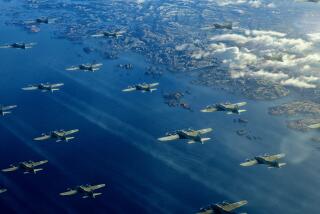Racers’ Nemesis : Lancaster Speed Demon Snags 2 Prestigious Air Racing Prizes
As a child, Jon Sharp used to “fly” a plane that was attached to a short wire. As an adolescent, it was remote-controlled airplanes. As an adult, he is still playing with small aircraft.
Only this one weighs more than 500 pounds and races around a three-mile oval course at better than 250 m.p.h.
Sharp, 44, of Lancaster, built and pilots an “air racer” called Nemesis that has set a host of speed records and dominated the Formula One racing class since it appeared on the circuit in 1991.
He set a national speed record Aug. 1, 1993, at the Aeroshell Speed Dash in Wisconsin, where he piloted the long, smooth and slender Nemesis at 277.26 m.p.h.
On Friday, he will be recognized by the National Aeronautic Assn. for his performance during the 1993 race season, receiving air racing’s most prestigious award, the Pulitzer Trophy, which is kept on display at the National Air and Space Museum in Washington. Top pilots in four other air race classes will also be honored with the Pulitzer.
Air racing is similar to auto racing except that it is done about 50 feet off the ground. The planes speed along a three-mile oval course. The 24-mile races take about 6 1/2 minutes to complete.
Sharp on Friday will also receive the Louis Bleriot Medal, an international award named for a French aircraft builder and designer who won the first air race in 1912 against the likes of the Wright brothers and other aviation pioneers.
The Council of the Federation Aeronautique Internationale awards a maximum of three of the medals each year to holders of speed, altitude and distance records in planes weighing less than 2,204 pounds.
“Not in my wildest dreams did I ever think it would be this successful,” Sharp said of his plane and the Nemesis Air Racing Team. “Most of this is pretty numbing to us.”
Sharp, who earns his living as a composites research engineer at Lockheed Advanced Development Co., says his desire to race dates back to his childhood.
“I raced everything from pedal cars to tricycles to slot cars,” he said. “I’ve raced a lot of people from stoplights.”
Shortly after Sharp earned his pilot’s license in the early 1970s, a co-worker told him about a home-built racing plane, a Cassutt Racer, that was for sale. Sharp bought it.
“I didn’t race it for a long, long time,” he said. “I just flew it around to air shows and terrorized airports and that kind of stuff. It was a little, itty-bitty, tiny airplane.”
In 1977, Sharp got a call from a friend who invited him to bring his Cassutt to a race in Mexico. “We came in last by a real long way,” he said.
But the next year, Sharp did a little better in that race. And then he ran into a friend who used to build engines, and in the 1978 Cleveland Air Races, Sharp and his plane actually “got past a couple people.” From that point, he said, “I was hooked.”
A few years later, Sharp joined up with a pair of Orange County engine builders who through their company, Aero Mag, began constructing engines specifically for racing. Sharp won his first national title at the Reno National Championship Air Races in 1982 with such an engine in the Cassutt.
In 1990, Sharp and his team began building Nemesis. The name was selected based on what they hoped to do with the plane. “We thought of all the typical names--Eliminator, Annihilator. We didn’t want to eliminate anybody. We just wanted to be the thorn in their side.”
That’s exactly what Nemesis has been, winning 19 of the 21 air races in which Sharp has flown it, and garnering four national titles.
Bruce Bohannon, an air racer from Texas who often finishes second behind Nemesis, says the plane is the most modern racer on the circuit.
“We’ve been chasing them with a much older-design airplane,” he said. “We’re slowly catching them by learning more and more ourselves.”
The fact that everyone on Sharp’s team is involved in the aerospace industry is a key to the plane’s success, Bohannon said. “It’s really difficult to beat a team that’s as well dialed in as they are,” he said.
Nemesis, made of composite materials, was built in 15 months of evenings and weekends at a Mojave Airport hangar. Sharp flew it for the first time in July, 1991, and that September it won the national championship.
“It’s a great airplane,” said Ray Cote, a 26-year veteran of air racing and holder of more Formula One national titles than anyone else. “It’s way out in front, way ahead of all the others.”
More to Read
Sign up for Essential California
The most important California stories and recommendations in your inbox every morning.
You may occasionally receive promotional content from the Los Angeles Times.










